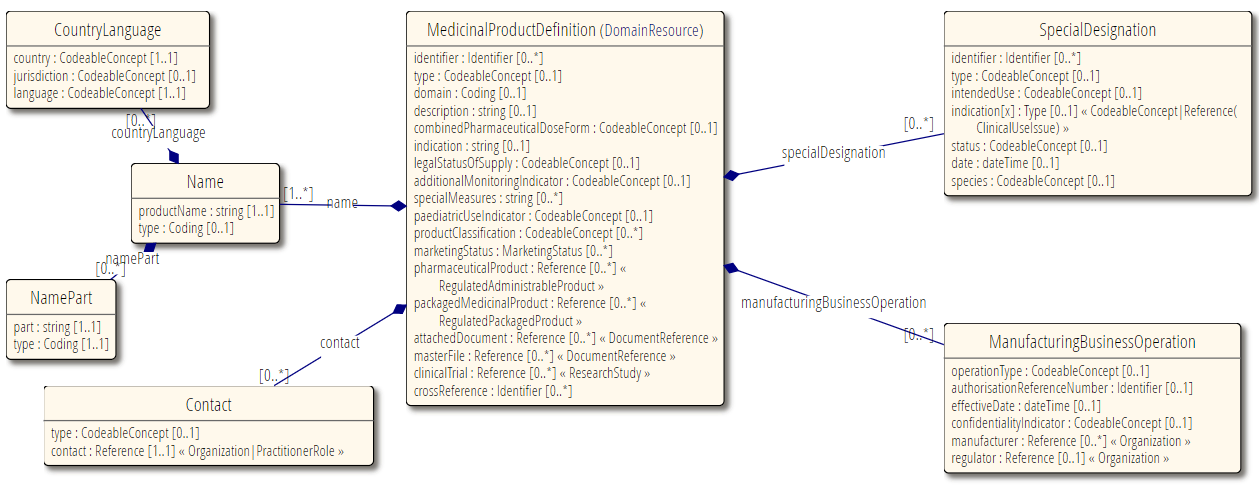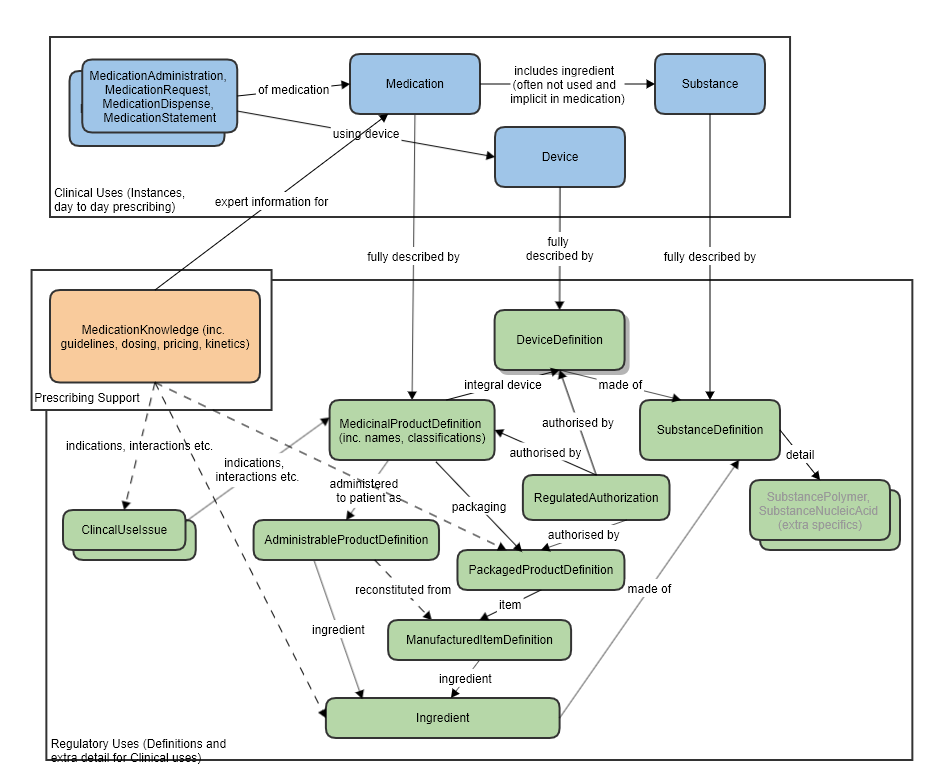MedicinalProductDefinition FHIR Resource Proposal
Contents
- 1 MedicinalProductDefinition
- 1.1 Owning work group name
- 1.2 Committee Approval Date:
- 1.3 Contributing or Reviewing Work Groups
- 1.4 FHIR Resource Development Project Insight ID
- 1.5 Scope of coverage
- 1.6 RIM scope
- 1.7 Resource appropriateness
- 1.8 Expected implementations
- 1.9 Content sources
- 1.10 Example Scenarios
- 1.11 Resource Relationships
- 1.12 Timelines
- 1.13 gForge Users
- 1.14 When Resource Proposal Is Complete
- 1.15 FMG Notes
MedicinalProductDefinition
Draft resource in build:
Owning work group name
Committee Approval Date:
6th May 2019 (earlier approval as "MedicinalProduct" 13th September 2017)
Contributing or Reviewing Work Groups
- Pharmacy
- Orders and Observations
- Clinical Decision Support
FHIR Resource Development Project Insight ID
1367
Scope of coverage
MedicinalProductDefinition is to be used when you need to describe a medicinal product itself, in detail, typically for regulatory or manufacturing use cases. This detail would very rarely, if ever, be needed when prescribing – for which the correct resource is Medication.
In scope:
Drug type and classification.
Official (and structured) names in different territories.
Manufacturing information, legal status, special/paediatric uses, Master File information, clinical trial use, marketing status.
Links to the administrable form of the product (once re-constituted from the product components), and the packaging aspects.
Some other closely related information is in scope of other proposed resources, but not in scope of this resource:
Detailed packaging information (PackagedProductDefinton),
Pharmaceutical aspects of the product (AdminstrableProductDefinition)
Physical aspects (including other non-medication objects that may be in the package – but not “devices” as such – see below). (ManufacturedItemDefinition)
Regulatory authorizations (RegulatedAuthorization)
Details of ingredients (Ingredient) and their substances (SubstanceDefinition).
Not in scope:
For day to day prescribing, the resource to use is Medication. This covers basic drug information – code, form, strength, batch number, simple ingredients.
Devices. This does not cover non-medication devices. See discussion below.
Pricing and contextual or local formulary information. For that see MedicationKnowledge.
Scope discussion:
The Medication resource covers mainly the use of a medication “by reference” (using a code), with only some basic extra optional information: form, strength, perhaps batch number and even less commonly used - simple ingredients. Many of those are rarely used because they are implicit in the code. So Medication doesn’t define medicinal products to any extent.
MedicinalProductDefinition resource covers the detailed defining data of medicinal products, to a level beyond what is typically need for day to day prescribing, but that is commonly required by manufacturers and regulators.
The “definition” suffix that indicates this is not an “instance” to be prescribed. (Also note however that when prescribing there is a duality of instance vs definition even in the Medication resource.)
“Devices” are not typically covered by this resource (except the small items that commonly come packaged with a drug, e.g. a bottle stopper), unless they have a pharmaceutical aspect.
Note that the lines between devices, biologicals and medicinal products are unclear in the real world, and this resource does not attempt to solve that issue by being prescriptive.
RIM scope
Similar in scope to the product parts of CPM. Entity: Material (EntityClass="MAT") determinerCode=KIND
Resource appropriateness
There is an outstanding requirement to support the standardised exchange of detailed "Product" data, for regulatory and other use cases.
This resource does not intend to clash with the existing Medication resource, but complements it with an extra level of detail. It is defnitional rather than about an instance of a medication (Also note however that when prescribing there is a duality of instance vs definition even in the Medication resource.)
It is seen as a sibling resource, in a definitional strata, rather than a parent or a "superclass" to be profiled.
(The superclass option has widely discussed and rejected, since this would mean the Medication resource - much more commonly used - would become more complicated, being a very small profile of a very large model. We don't want to introduce such confusing complexity in that space - which is largely separate.)
This resource has been designed in close consultation with Pharmacy WG, and in conjunction with the MedicationKnowledge resource
MedicinalProductDefinition is intended to add an extra level of product specification detail, such as is typically used by regulators, and only indirectly used during normal medication related work flows (e.g. for look-ups of unfamiliar products).
Drug manufacturers currently submit this data electronically to regulators, when products are registered or altered, or marketing situations change.
Expected implementations
EMA and European drug manufacturers, who have a requirement to submit to EMA (and already do so in a proprietary format). They are required to move to IDMP, and this is a good opportunity to use a standards-based FHIR solution.
FDA for drug submission (currently using SPL, which is not likely to change in the near term, but have expressed an interest in FHIR).
FDA for Pharmaceutical Quality (HL7 PSS approved, based on this resource, June 2019),
Content sources
A large amount of actual data of this kind exists in the EMA EU XEVMPD data base (and XEVPRM XML messages). Example FHIR data for several full product data sheets exists based on draft resources.
Also, information gained from early stage implementation of these resources at EMA (2018, 2019), and from many many received to EMA about the draft API specification from the European medicines regulatory network (https://www.ema.europa.eu/en/about-us/how-we-work/european-medicines-regulatory-network).
Also from FDA requirements (for PQ/CMC) and other workgroup review (BR&R, Pharmacy) and their comments. Current active work on this project, with this resource.
Example Scenarios
Pharma companies submit details of new products to regulators. Updates are made when necessary e.g. clinical particulars change (a new contra-indication), a new marketing authorization exists etc.
Pharmacies and prescribers can view and download this information for reference and integration with their systems.
Specific use cases include:
Submission of products from drug companies and NCAs (National Competent Authorities - the national regulators) to regional regulators. This is already implemented in Europe (by EMA and EU-wide stakeholders) with an earlier non-HL7 format (XEVPRM/XEVMPD). That scenarion is currently being re-implemented, using this resource, as part of the EU wide SPOR project.
Drug Manufacturing Quality information (aka PQ/CMC, Pharmaceutical Quality), as used by the FDA in the US. Specific plans to use this resource for that project.
Resource Relationships
For the relationship to other resources, see the diagram below.
High level relationships of the main prescribing resources and the regulatory strata below:
Also refer to the logical model which was used to clarify the resource relationships, at the request of FMG, in the preparation of this proposal (linked to the approved MedicationKnowledge proposal page): MedicationKnowledge_FHIR_Resource_Proposal
Some notable resource references: Reference to Organization, for the manufacturer, regulator and other establishments. Reference to DocumentReference, for the regulatory submission documentation. Reference to directly supporting resources such as RegulatedPackagedProduct. Incoming reference from resource RegulatedAuthorization. Indirect reference to DeviceDefinition, via the other proposed resources (DeviceDefinition was created with O&O with input from this IDMP project and includes our all of our device requirements). Indirect reference to proposed SubstanceSpecification resource to describe ingredients in detail.
MedicinalProductDefinition and Medication
This resource is intended to complement the Medication resource, which is focused on what is commonly needed for medical/clinical use cases. MedicinalProductDefinition adds information needed for regulatory use cases, of which there is little overlap to day to day prescribing.
Most aspects of MedicinalProductDefinition are not present in Medication at all, and are not current candidates for inclusion in the prescribe/dispense/administer workflow.
MedicinalProductDefinition and MedicationKnowledge
MedicationKnowledge resource is aimed at drug knowledge bases. There is partial overlap in scope between that resource and some aspects of regulatory use cases. To fulfil that, the common associated resources of MedicinalProductDefinition will be used (e.g. Ingredient, ClinicalUseIssue). MedicationKnowledge includes some local specifics such as pricing. The boundaries between all these resource have been carefully thought out and have had much discussion in workgroups (BR&R, Pharmacy, CDS) and with FMG representatives.
MedicationKnowledge
This resource differs from MedicationKnowledge in that MedicinalProductDefinition is a context-less, complete definition of the drug (typically as defined by the manufacturer and validated by a regulatory body), including all the intrinsic properties.
MedicationKnowledge is a description of the product in a context, such as a local formulary, and can include costing and local usage information.
There is some overlap in scope between MedicationKnowledge and the entirety of definitional information about the “Product” (which is more than is covered in MedicinalProductDefinition itself). Where the same data element exists in both contexts this is factored into a shared resource (e.g. ClinicalUseIssue, Ingredient, which are referenced from both).
The MedicinalProductDefinition resource differs from other proposed resources:
AdministrableProductDefinition
this covers the pharmaceutical as it is mixed, from the “manufactured” components in the pack, and as ready administered to the patient. This is a different concept to the overall product and to MedicinalProductDefinition specifically (though the “product” does incorporate both aspects, and this is managed by the APD being referenced from the MedicinalProductDefinition. In effect this is a new substance, that doesn’t exist in the product otherwise. In some cases e.g. a tablet, the administrable form is the same as the manufactured form.
PackagedProductDefinition
this covers one of the possible packaging versions of the product. There can be different packages (e.g. 10 tabs, 20 tabs) in the same “product”, but still treated as one product for licensing etc. This is managed by the multiple PPDs being referenced from the overarching MedicinalProductDefinition. The package can contain multiple Manufactured Items (ManufacturedItemDefinition) (the physical drug and solvents etc) which are then mixed to make the APD.
So:
MPD – as licenced
/ \
/ \____PPD1 or PPD2 – as supplied
/ / \
APD <-- MID1+MID2 (mixed)
\
as administered to the patient
MPD Medicinal Product (definition) MID Manufactured Item (definition) PPD PackagedProduct (definition) APD Administrable Product (definition)
Timelines
Draft content is modelled in the FHIR build (http://build.fhir.org/MedicinalProductDefinition.html), with outline supporting documentation. Completion planned Q4 2019.
gForge Users
riksmithies
When Resource Proposal Is Complete
When you have completed your proposal, please send an email to FMGcontact@HL7.org

